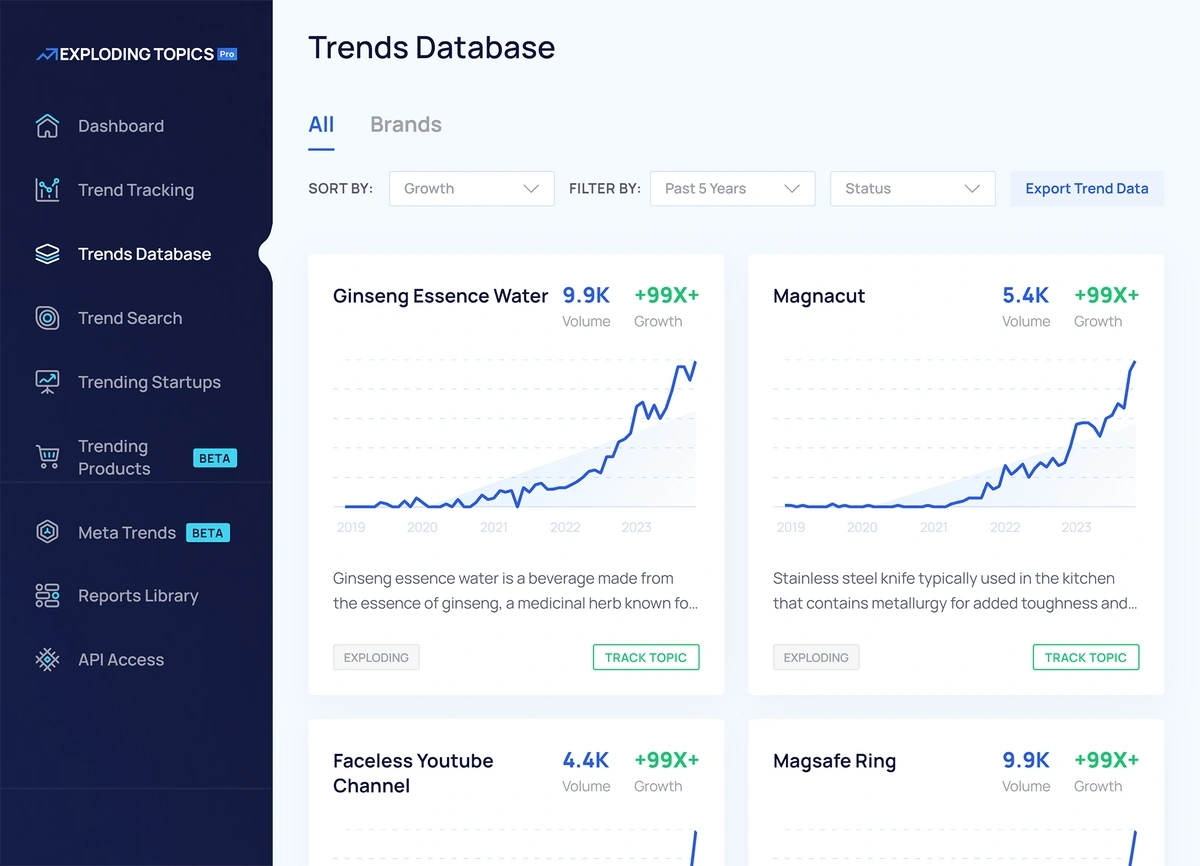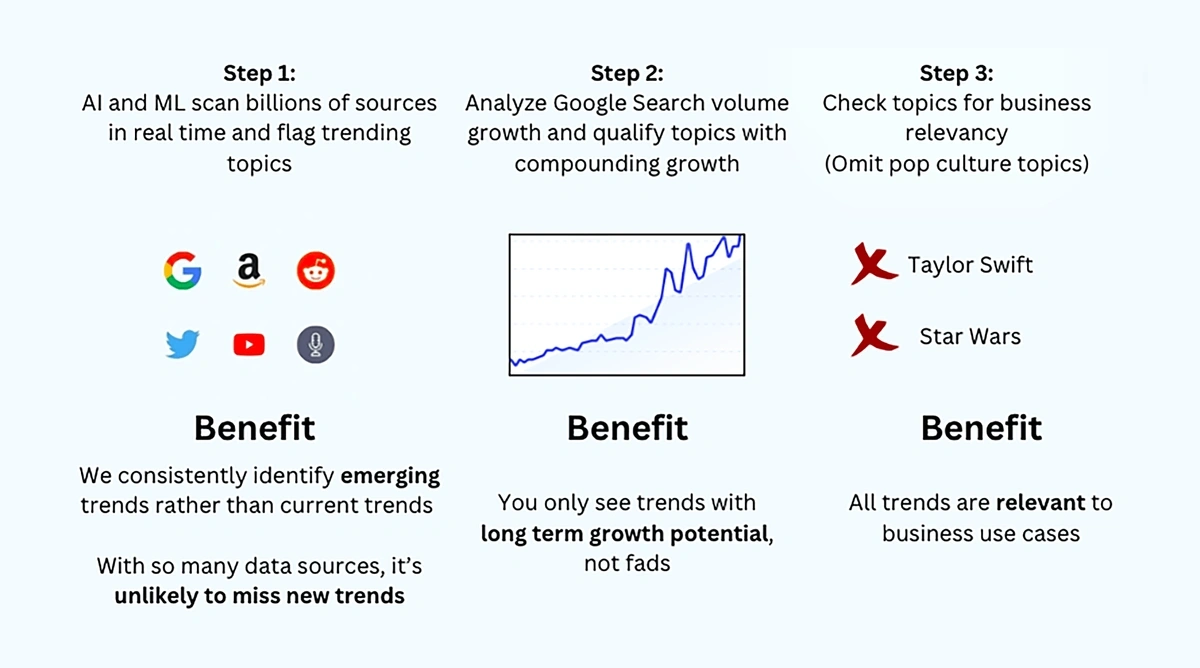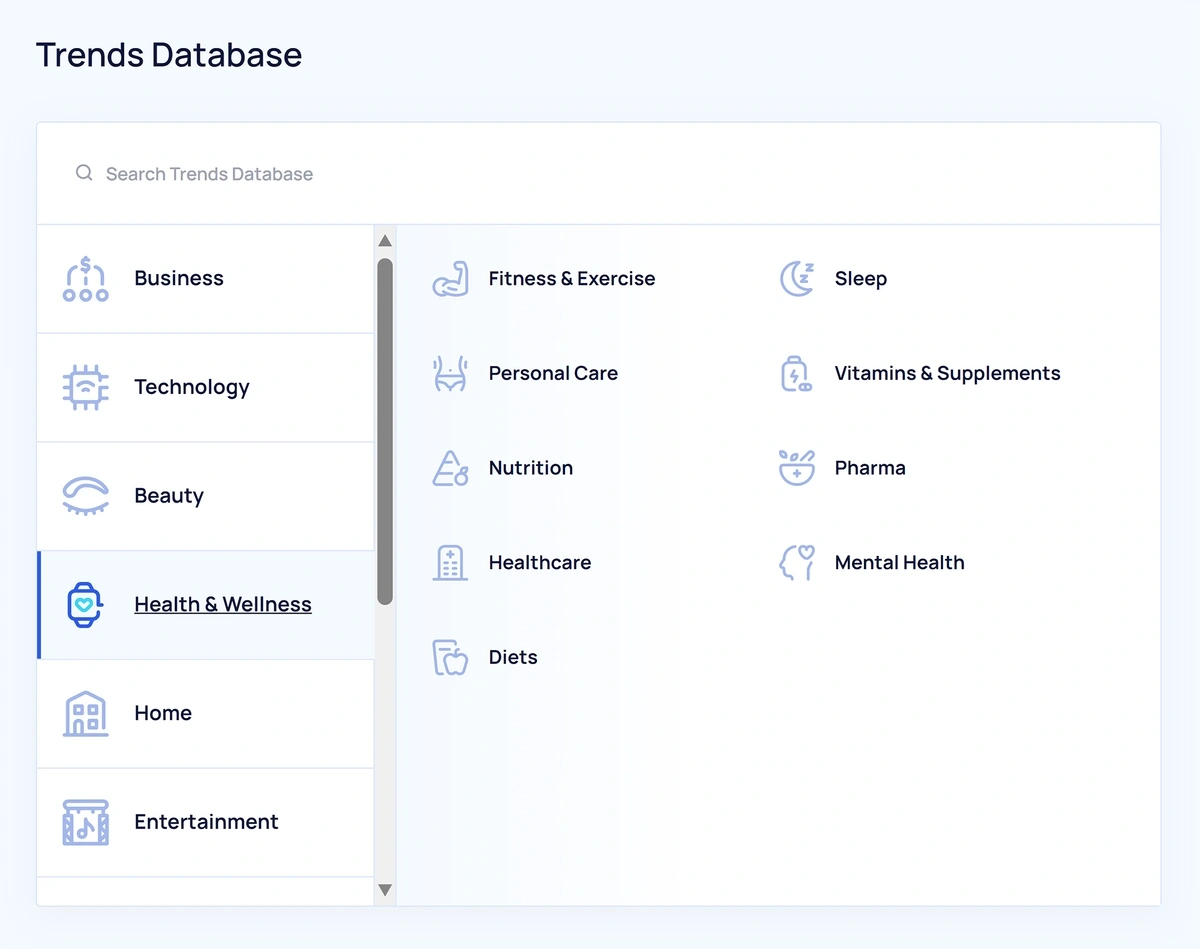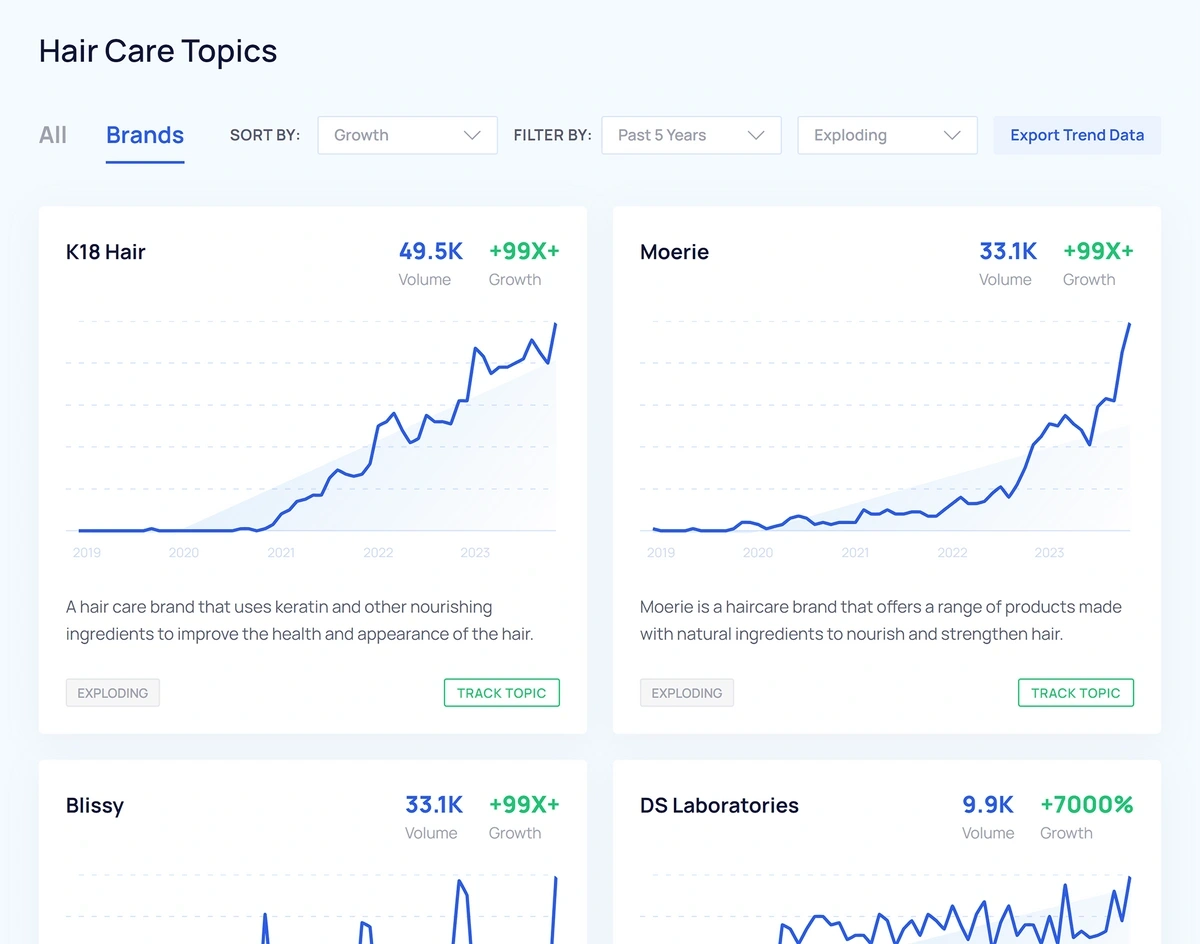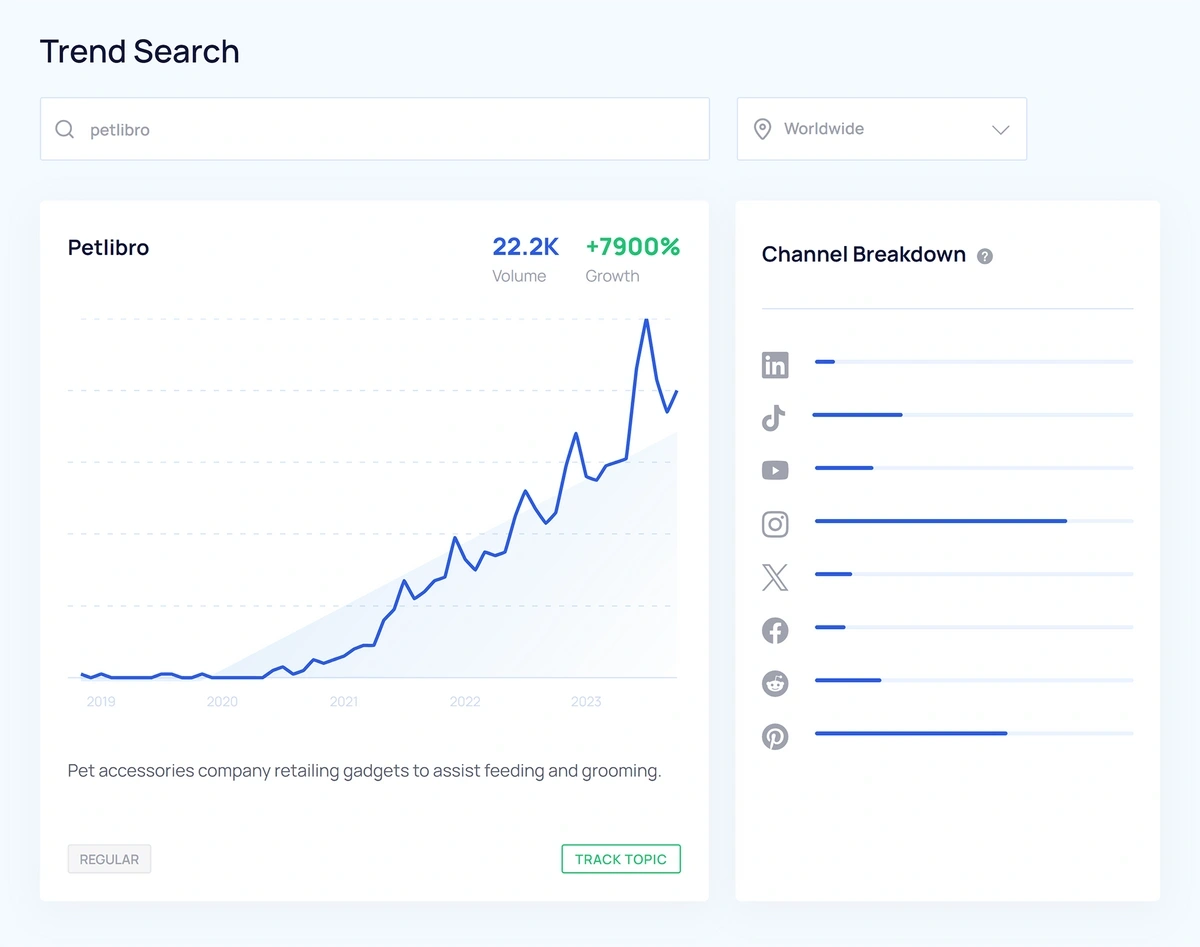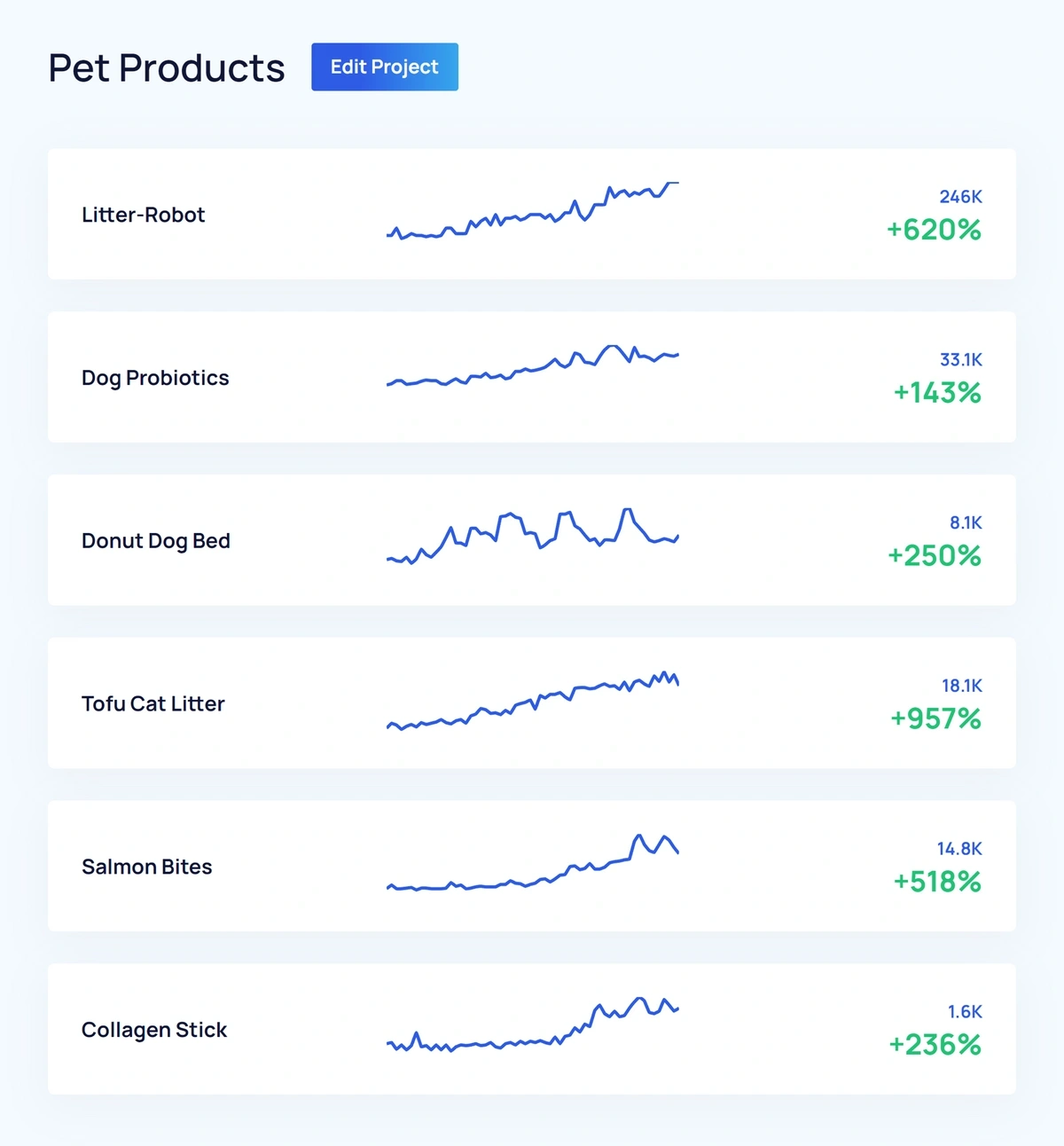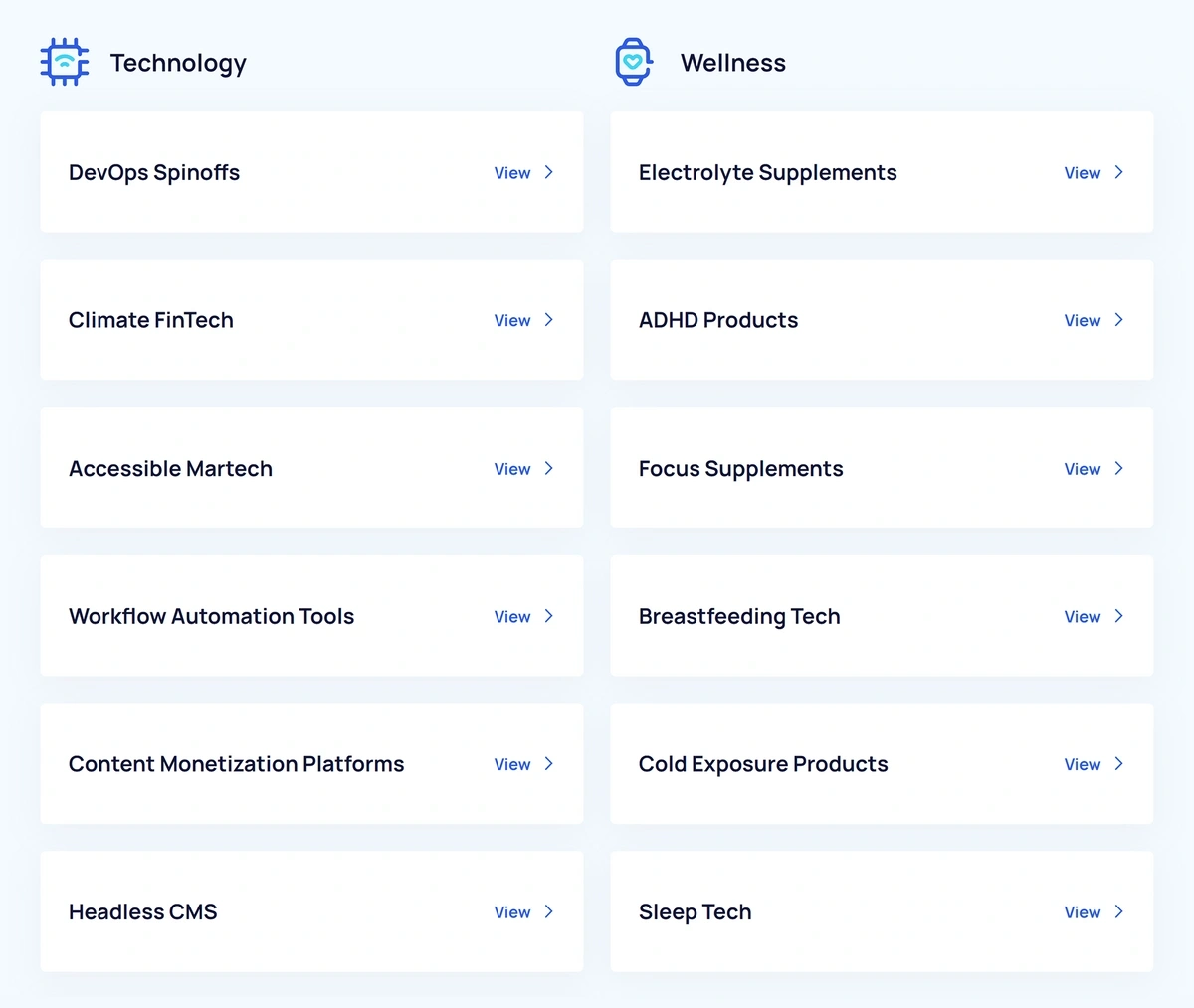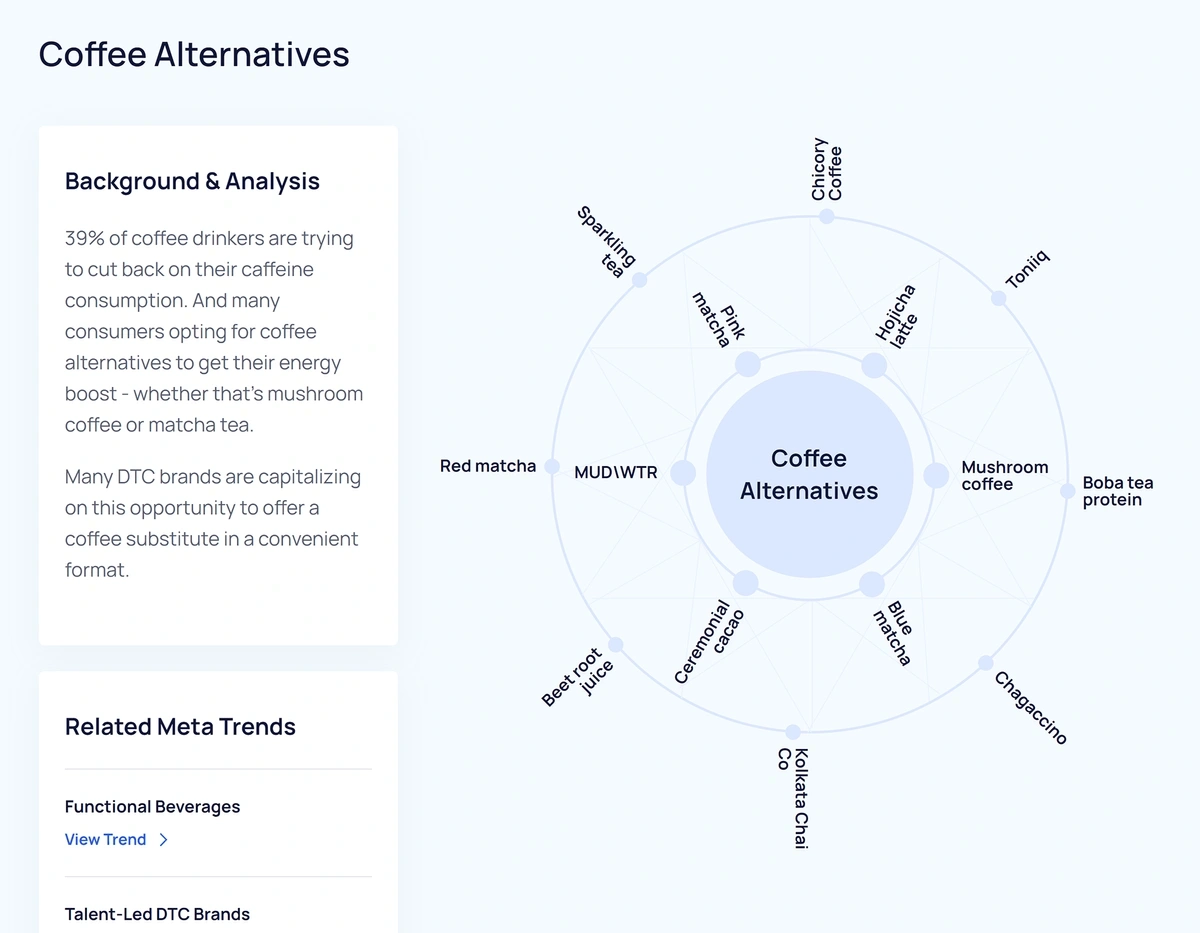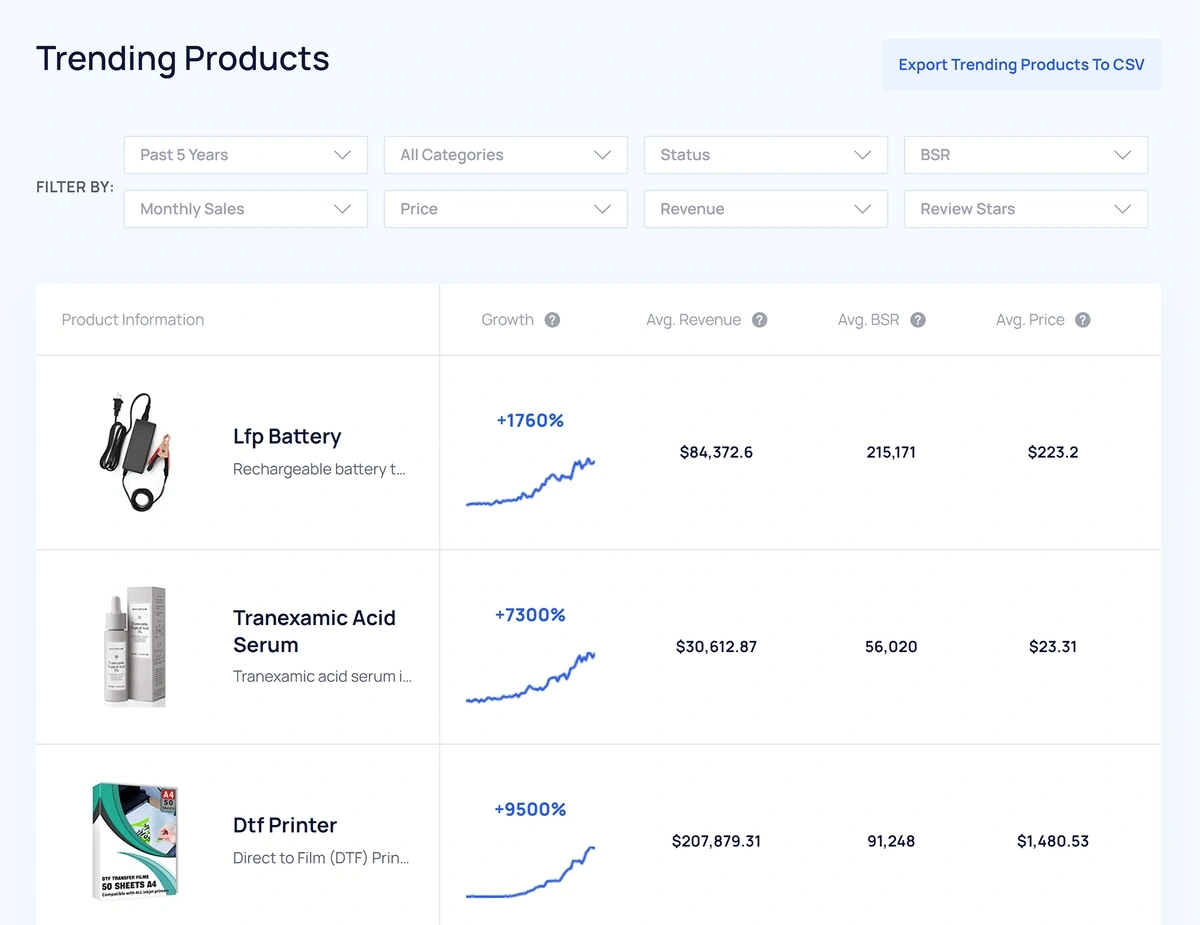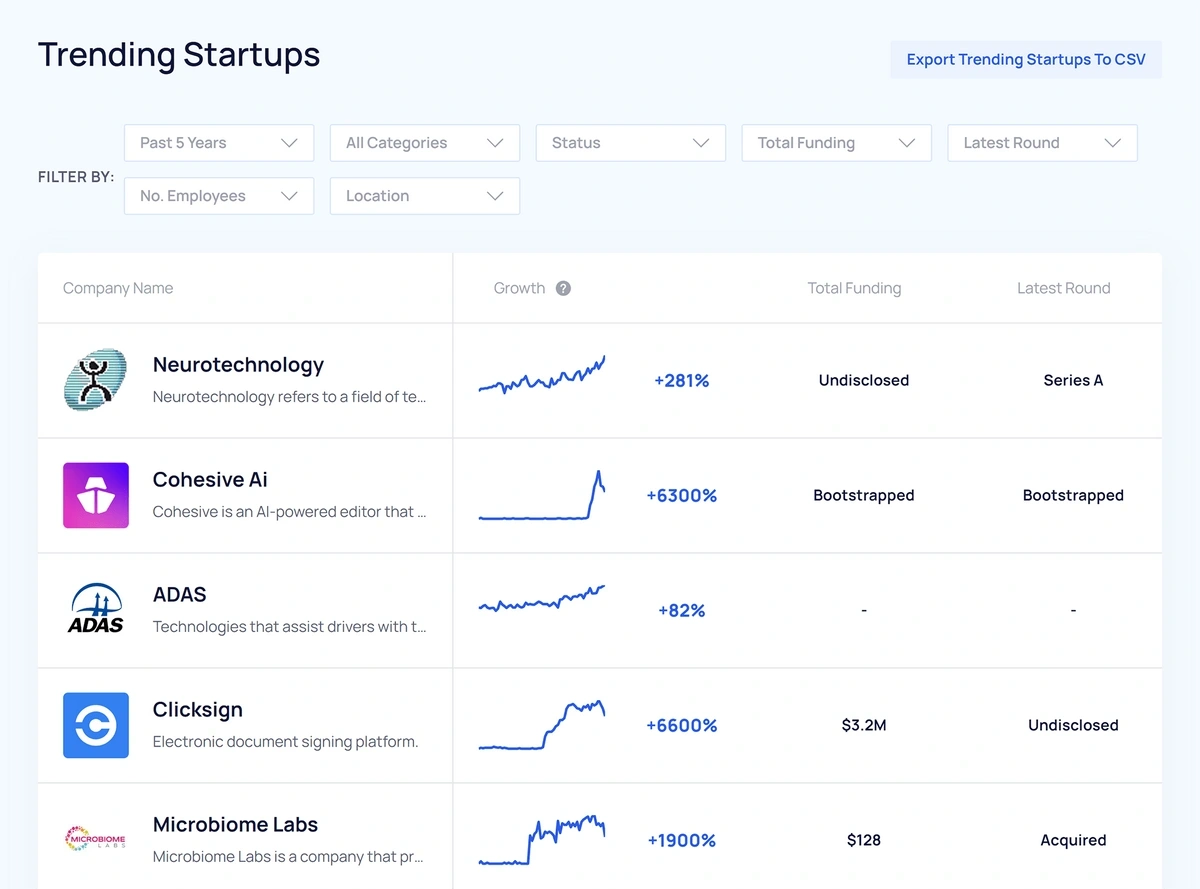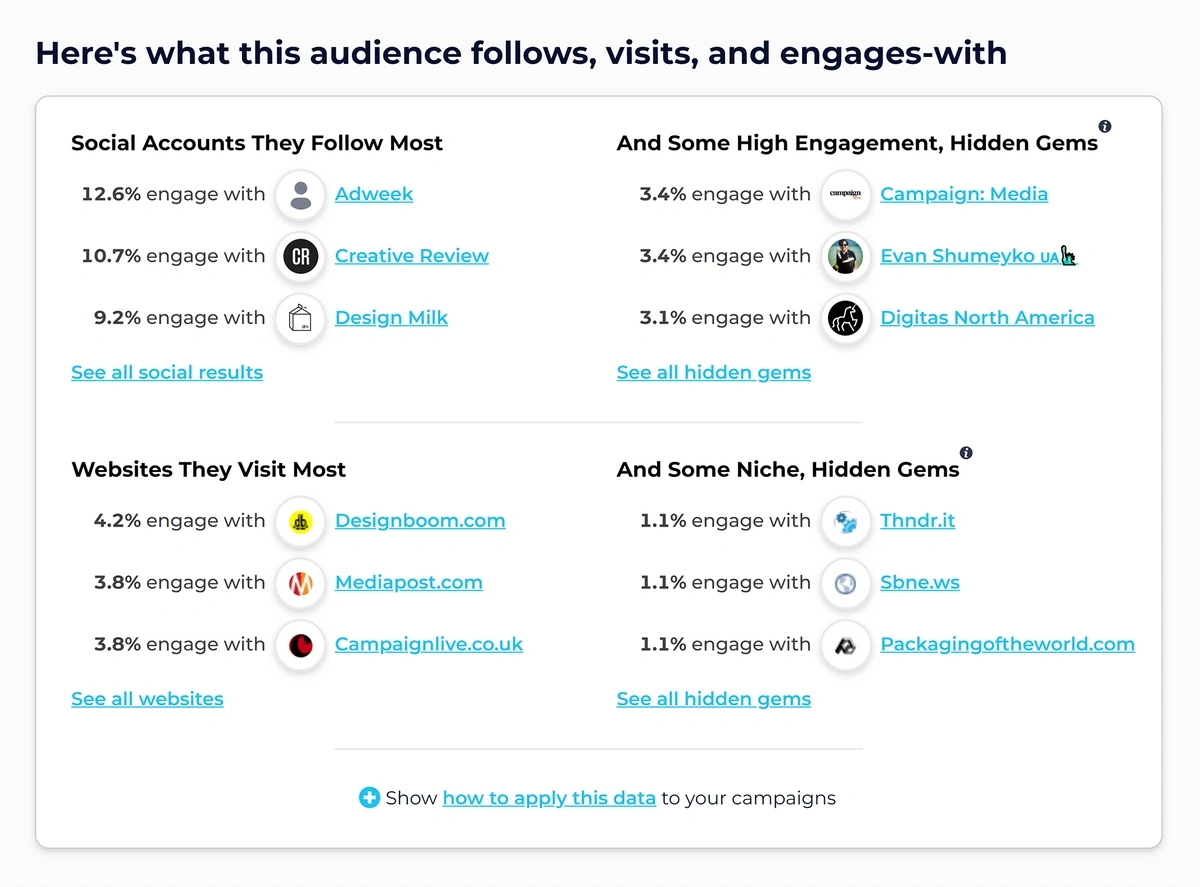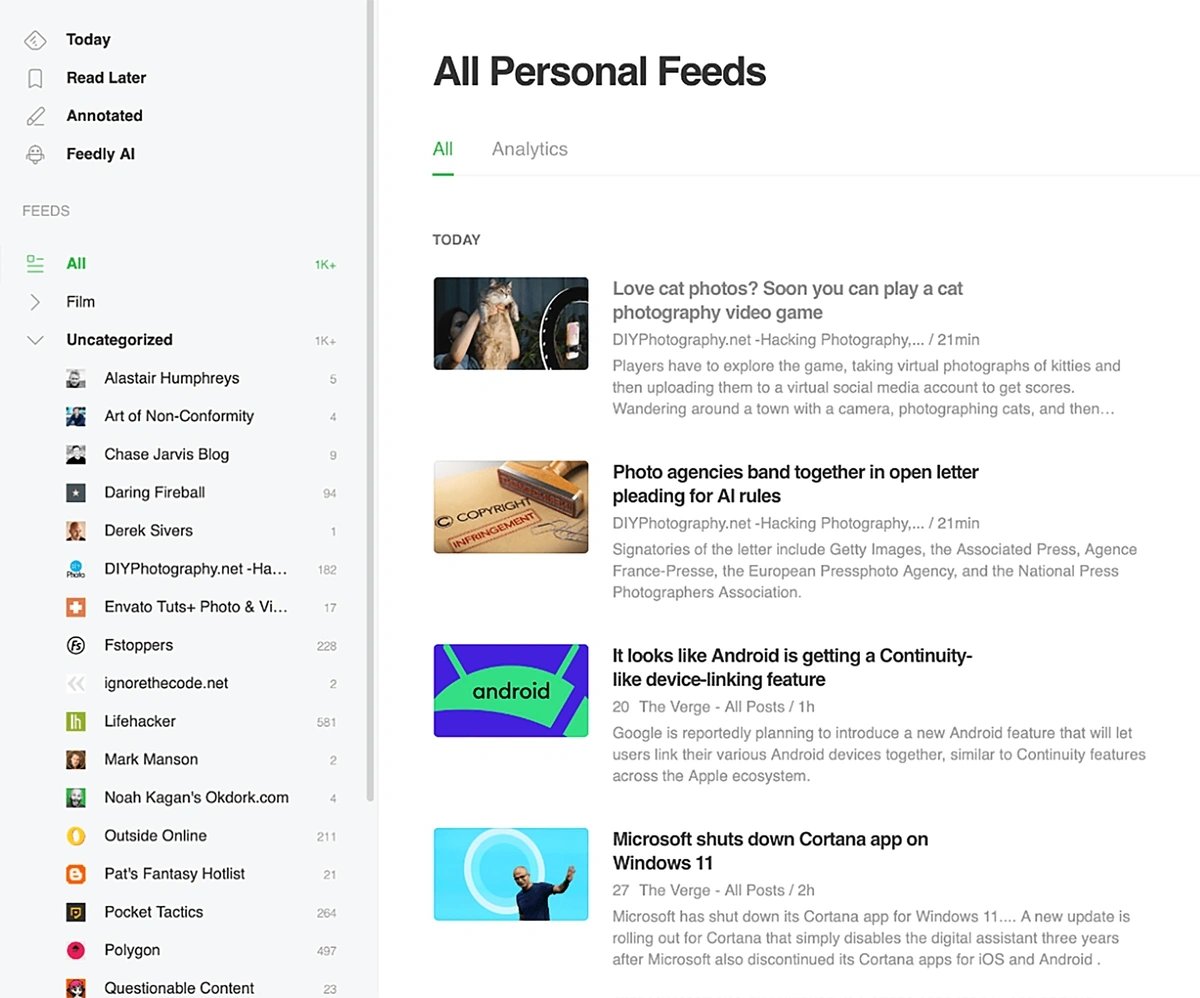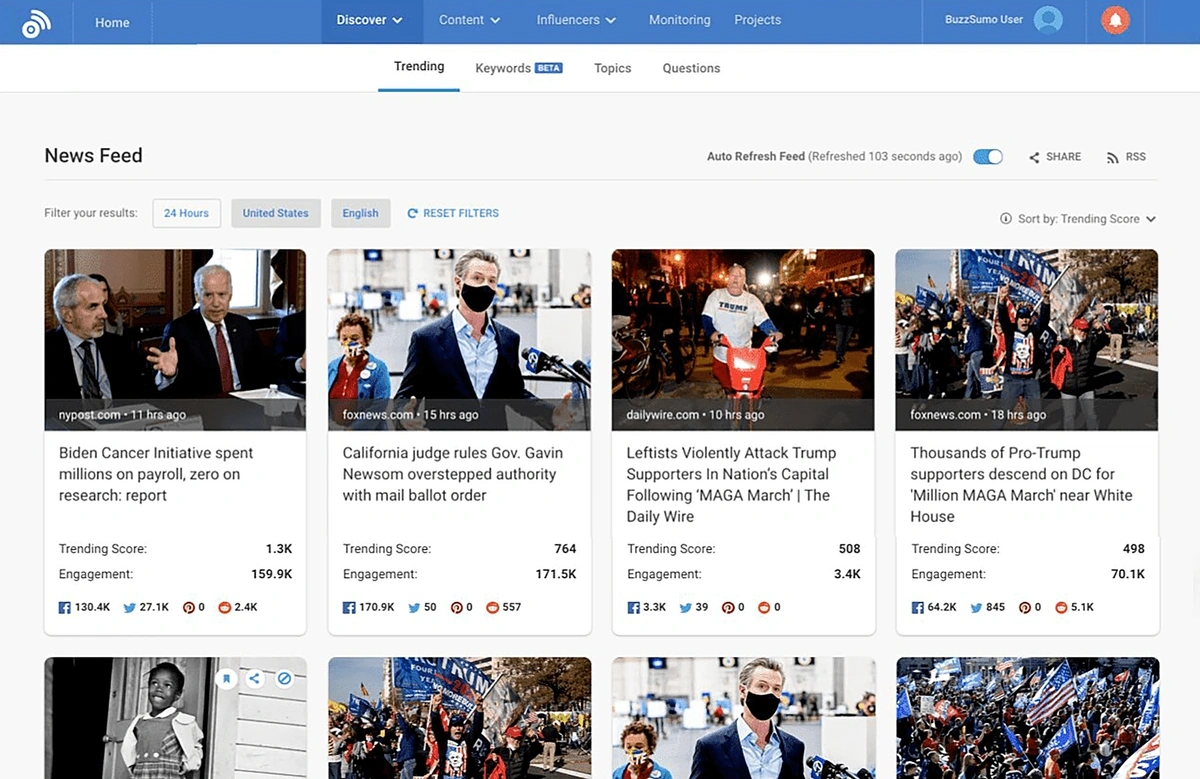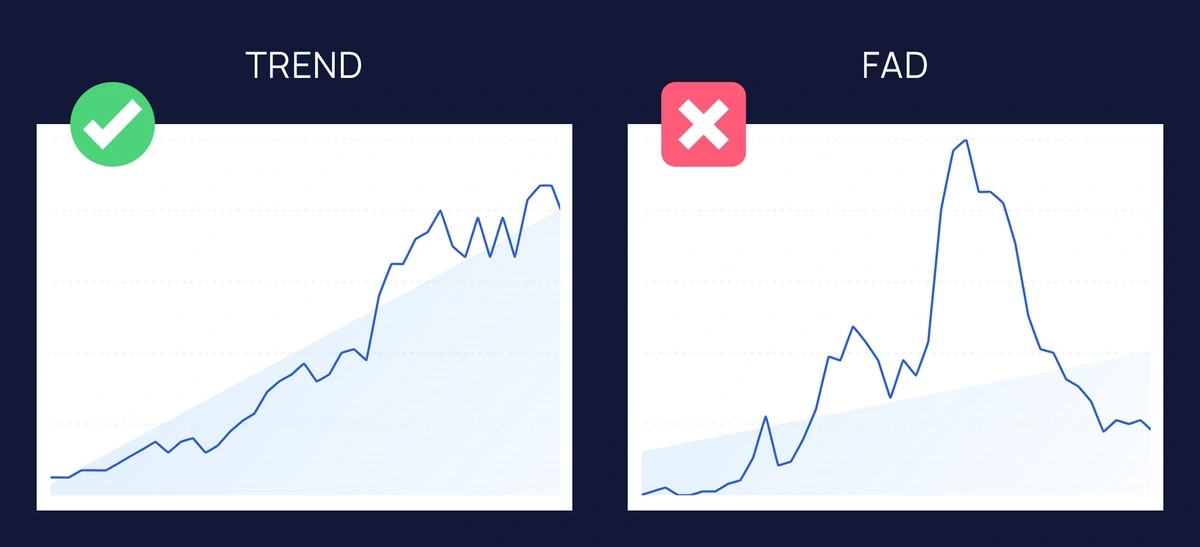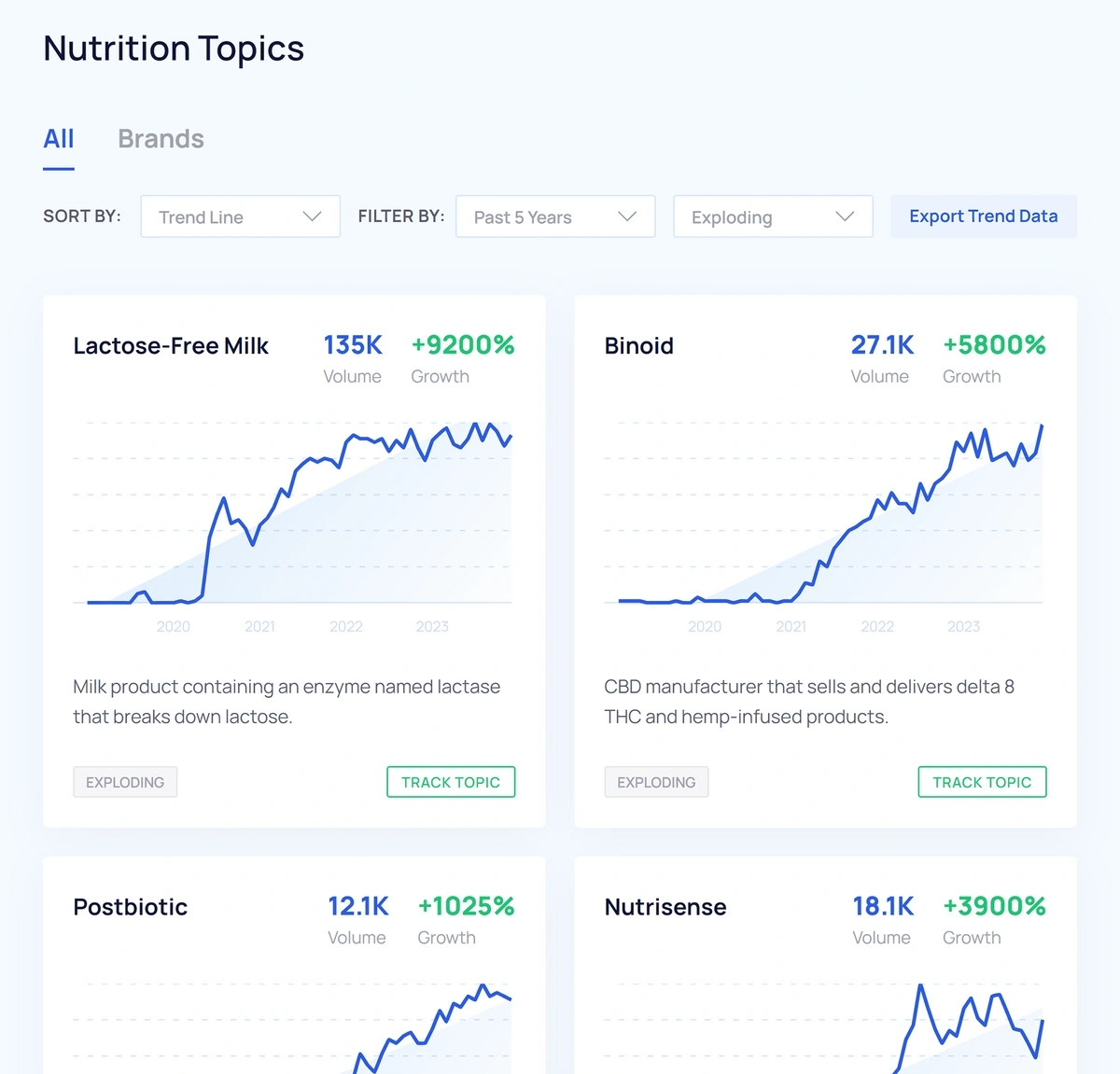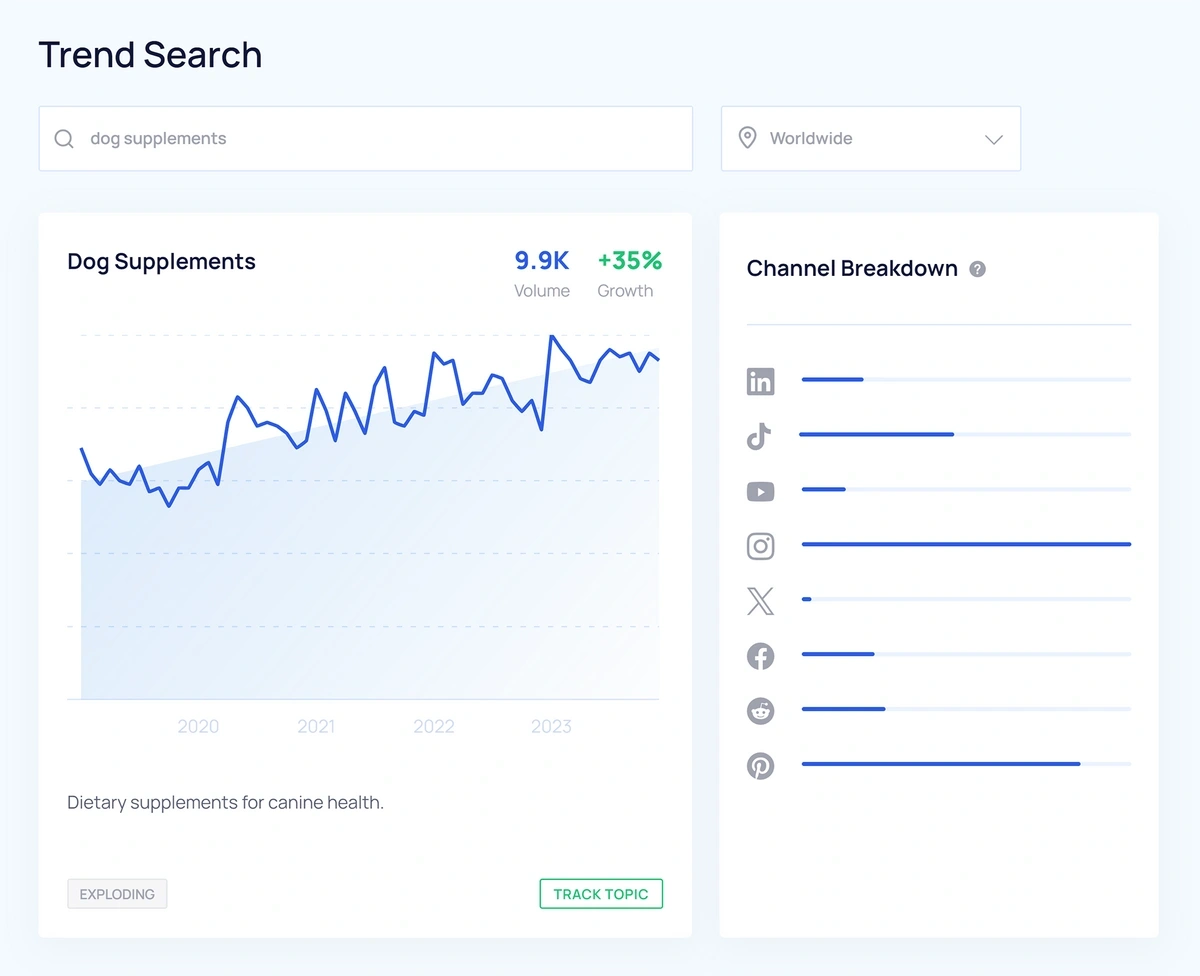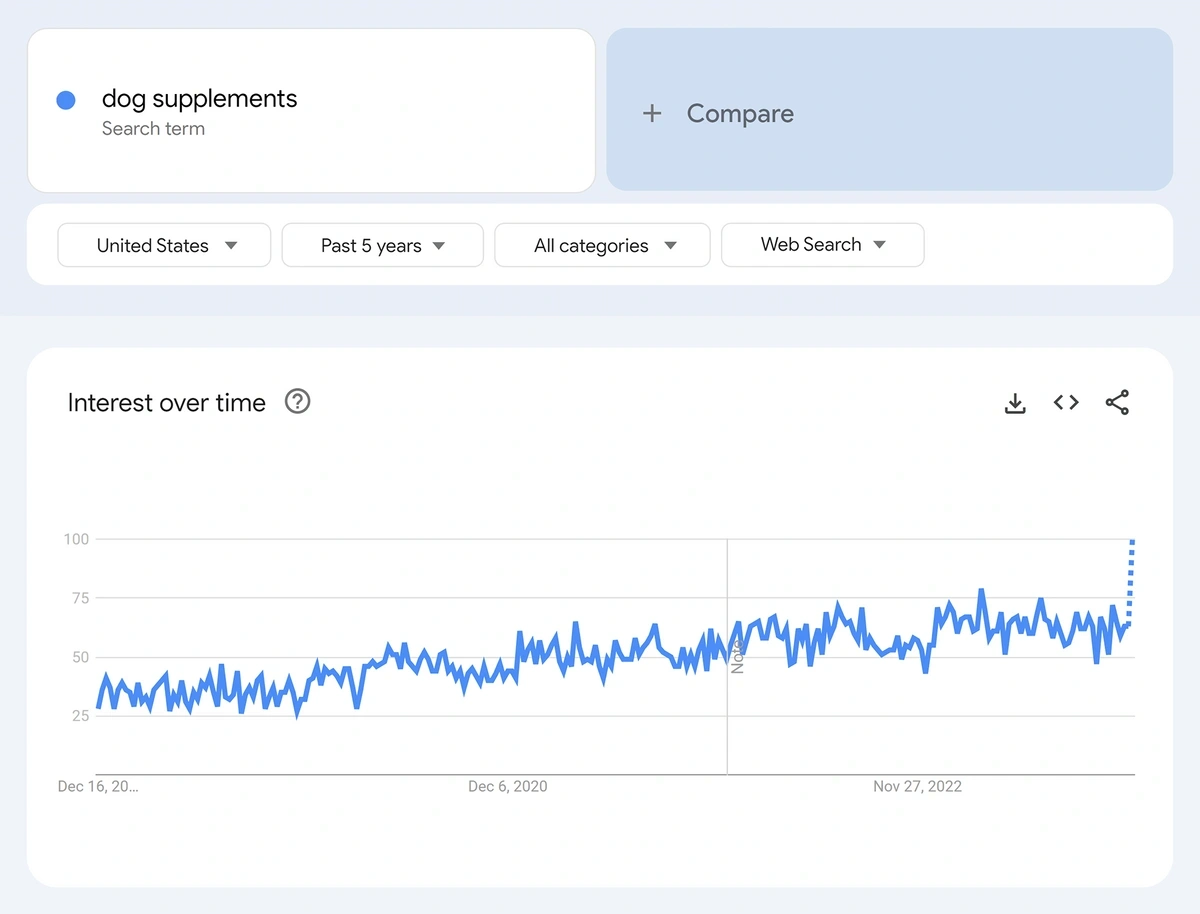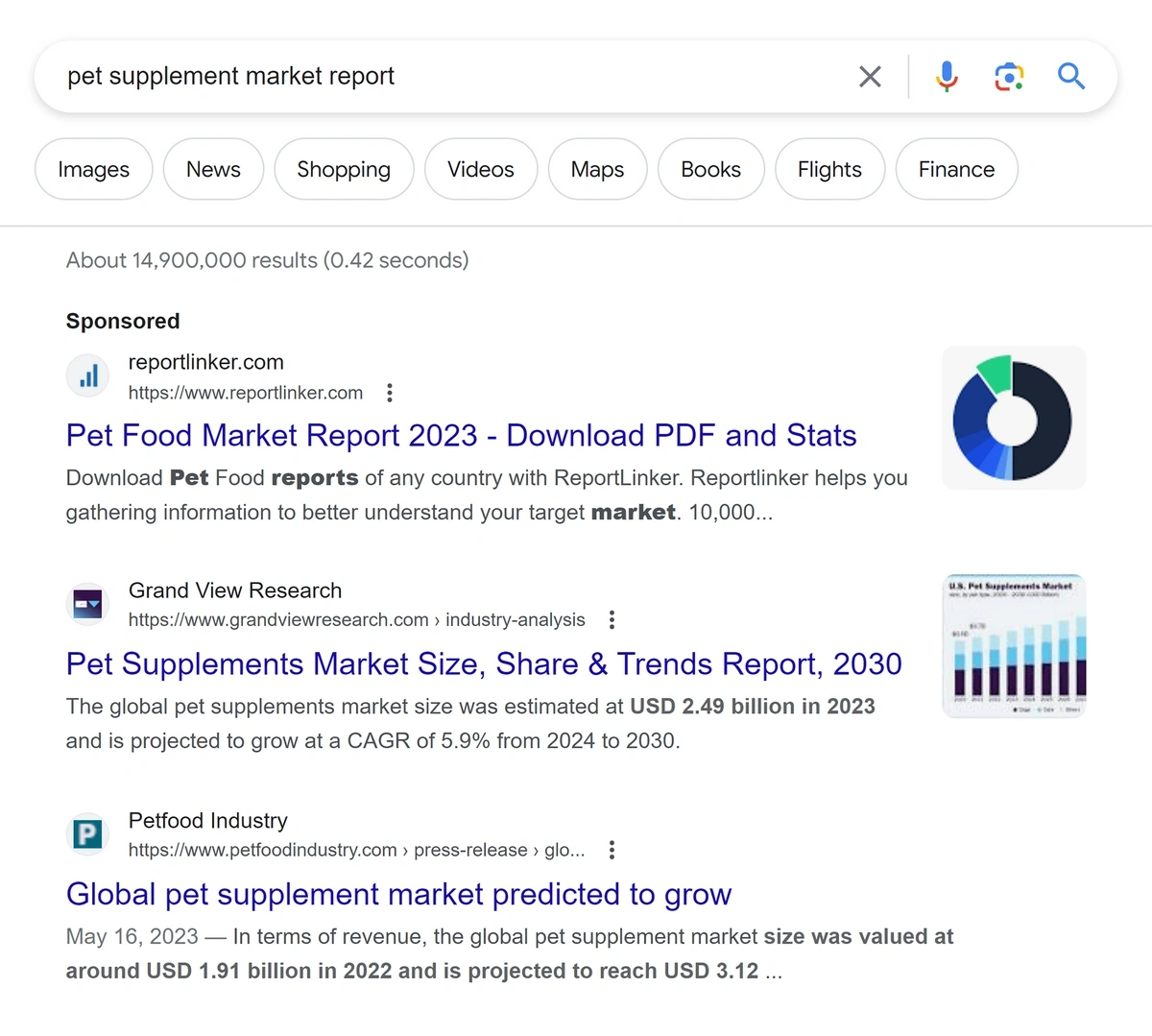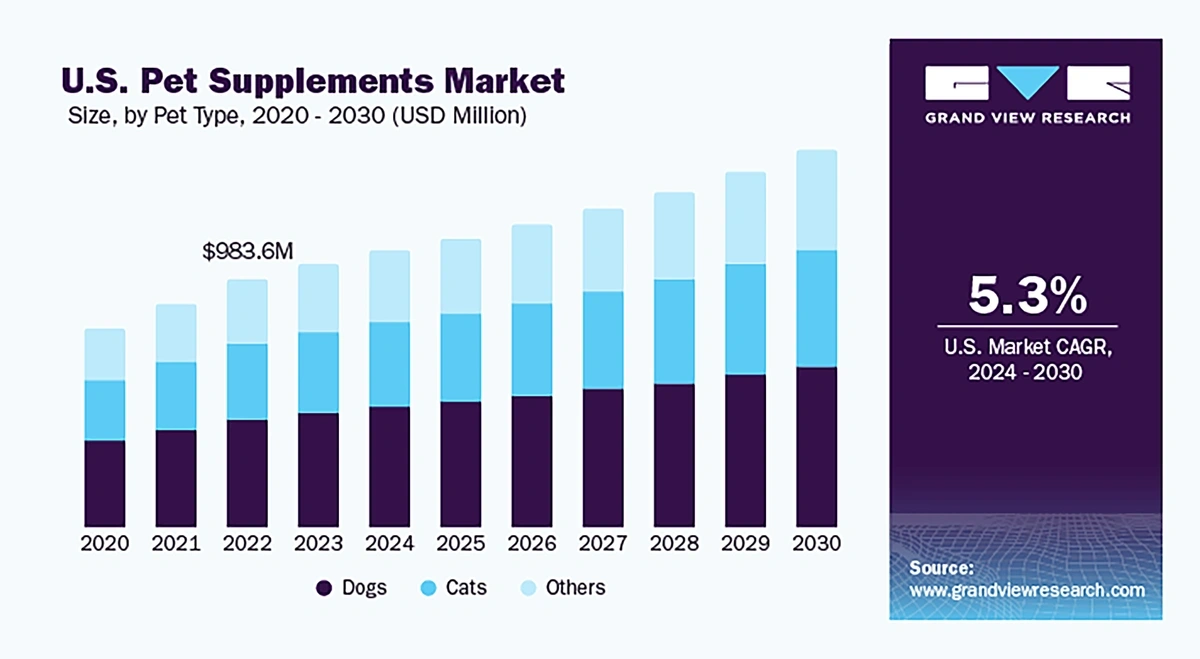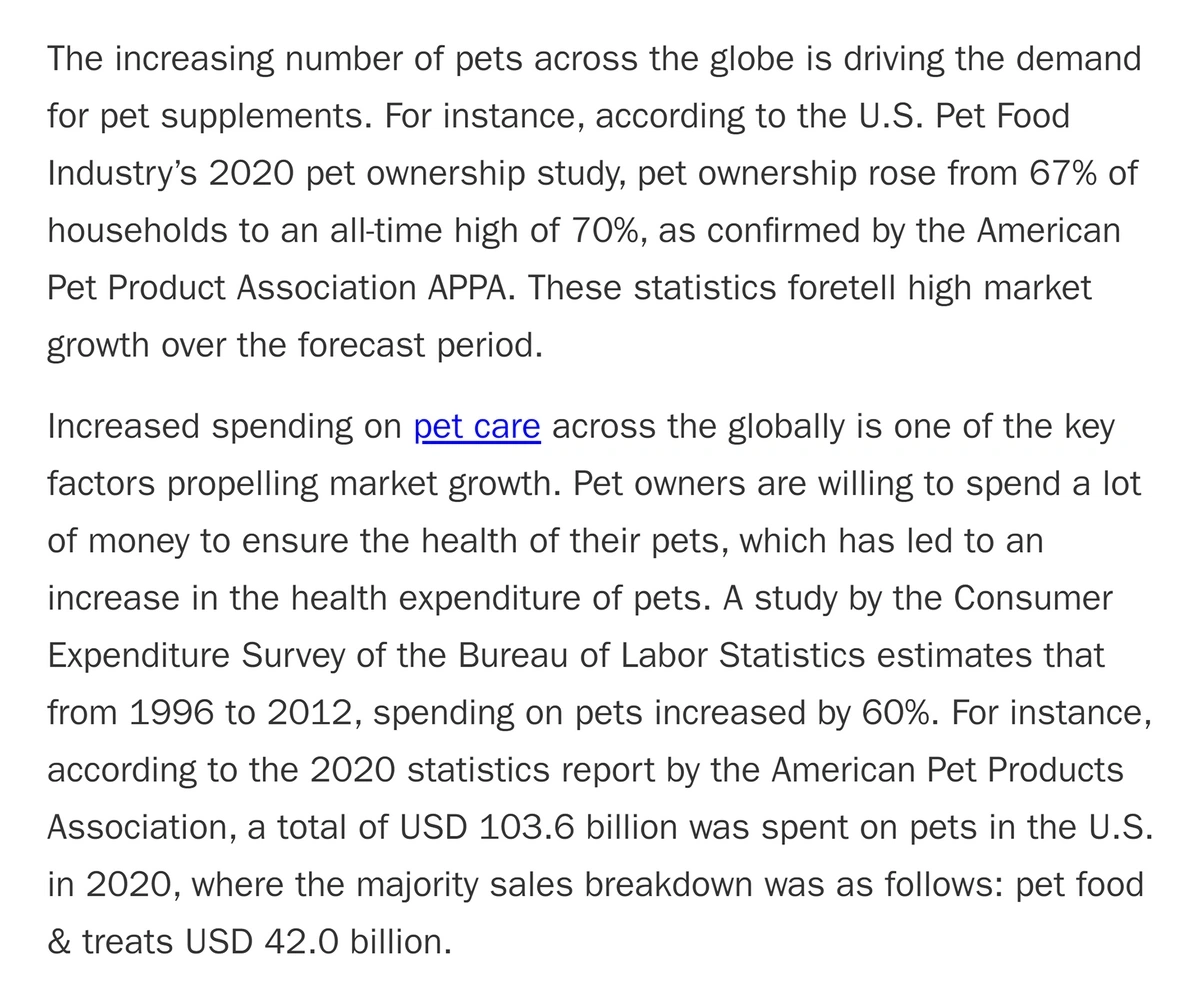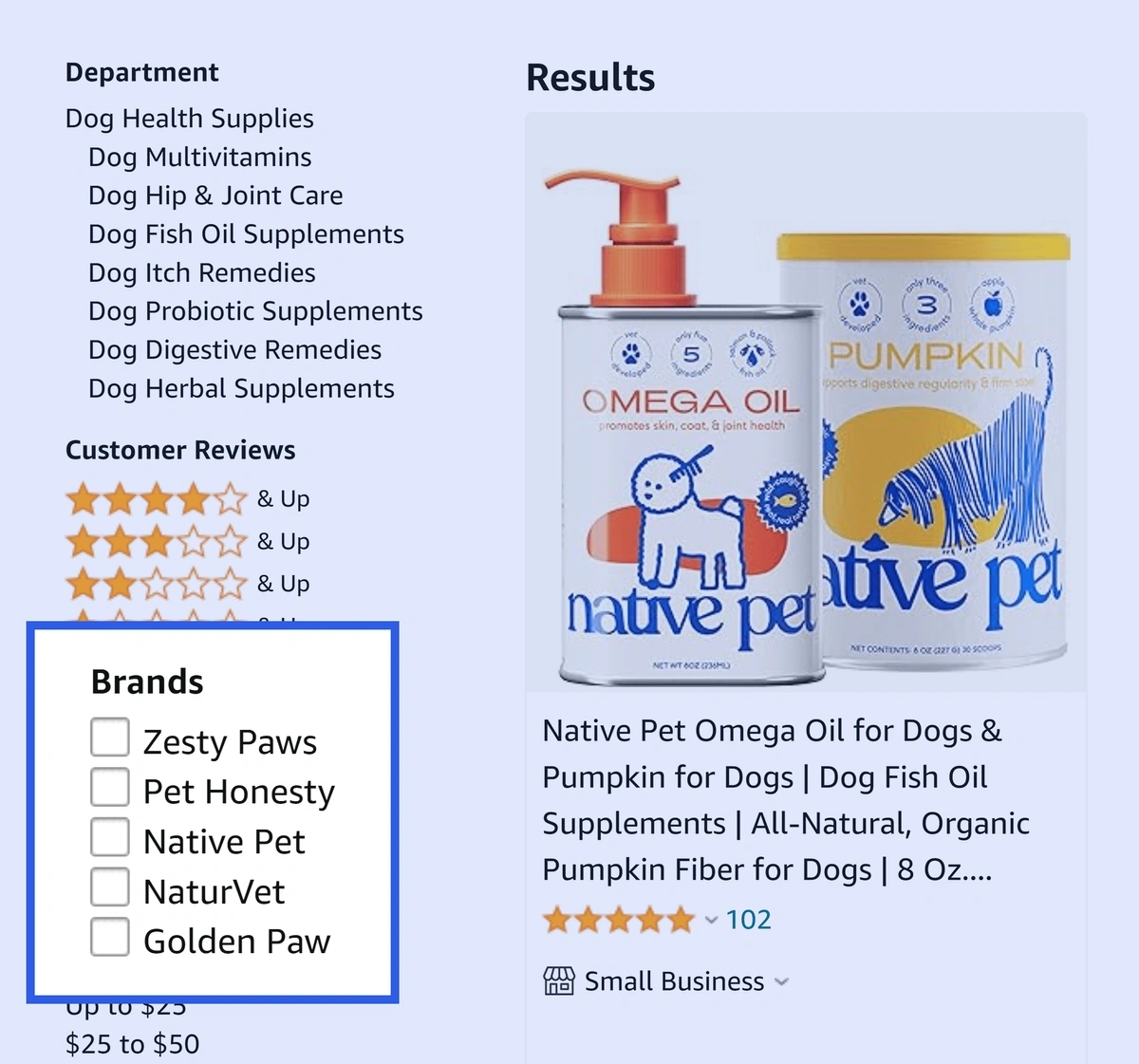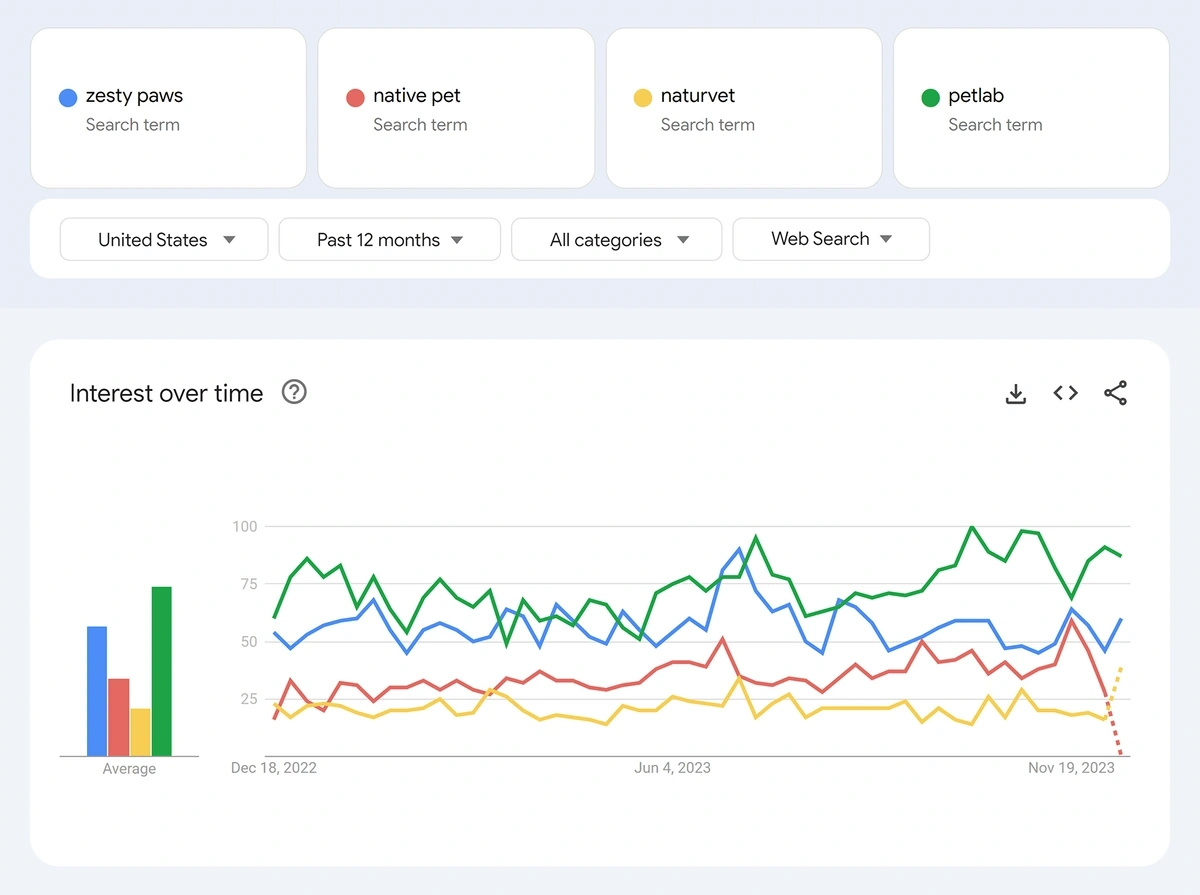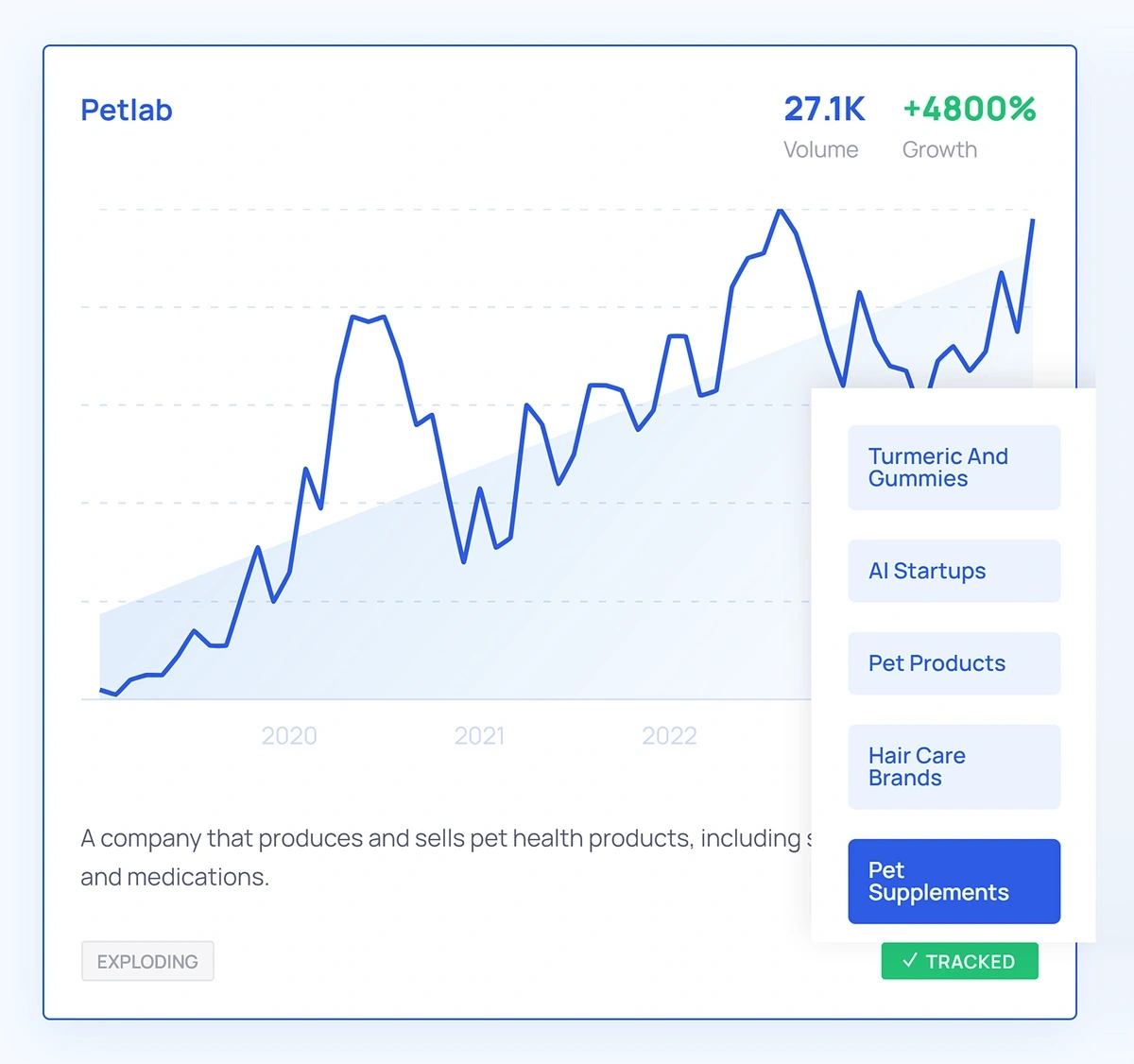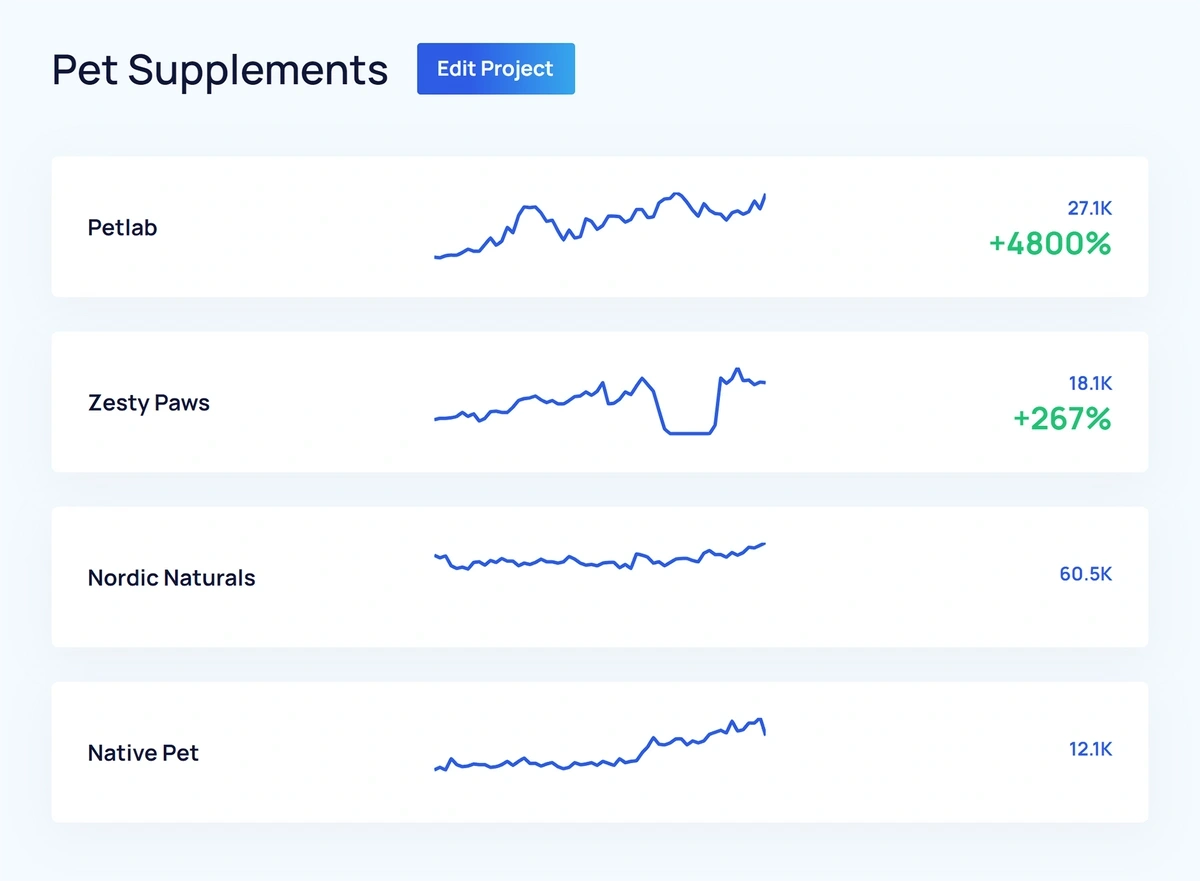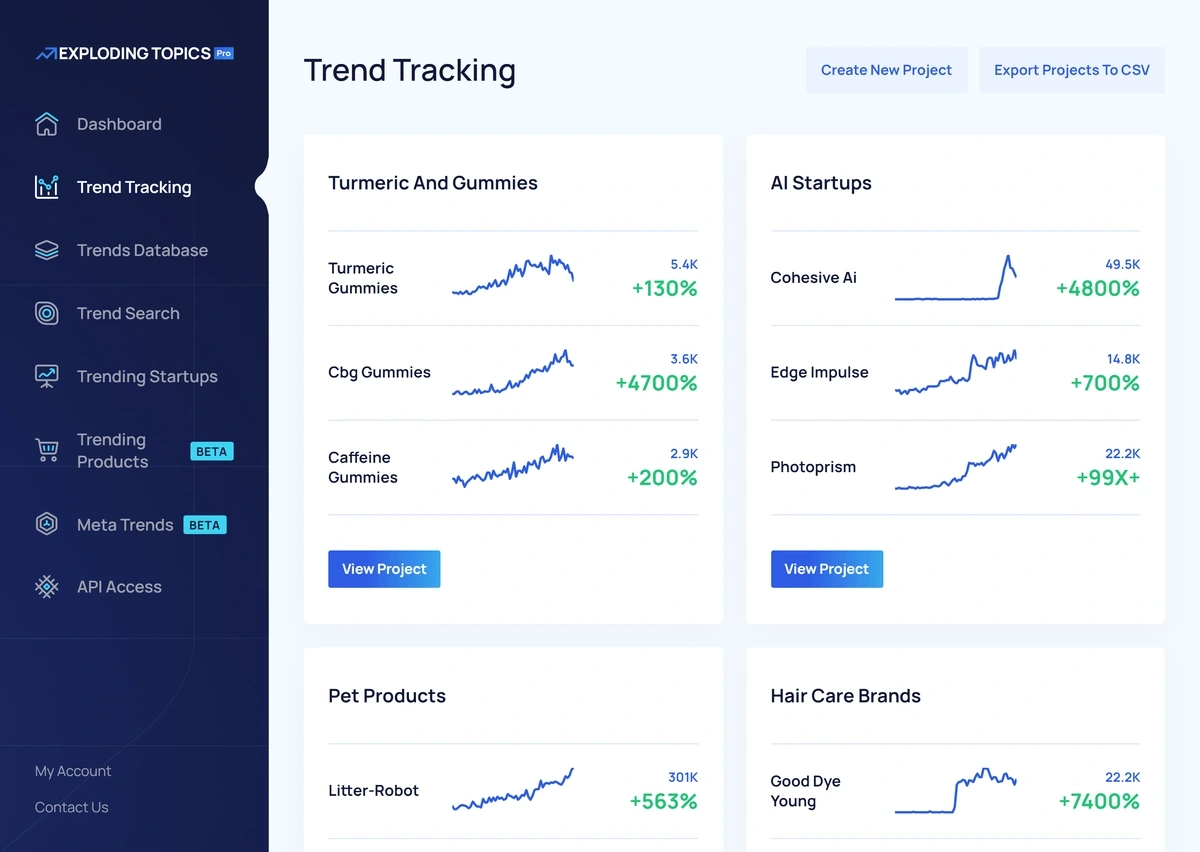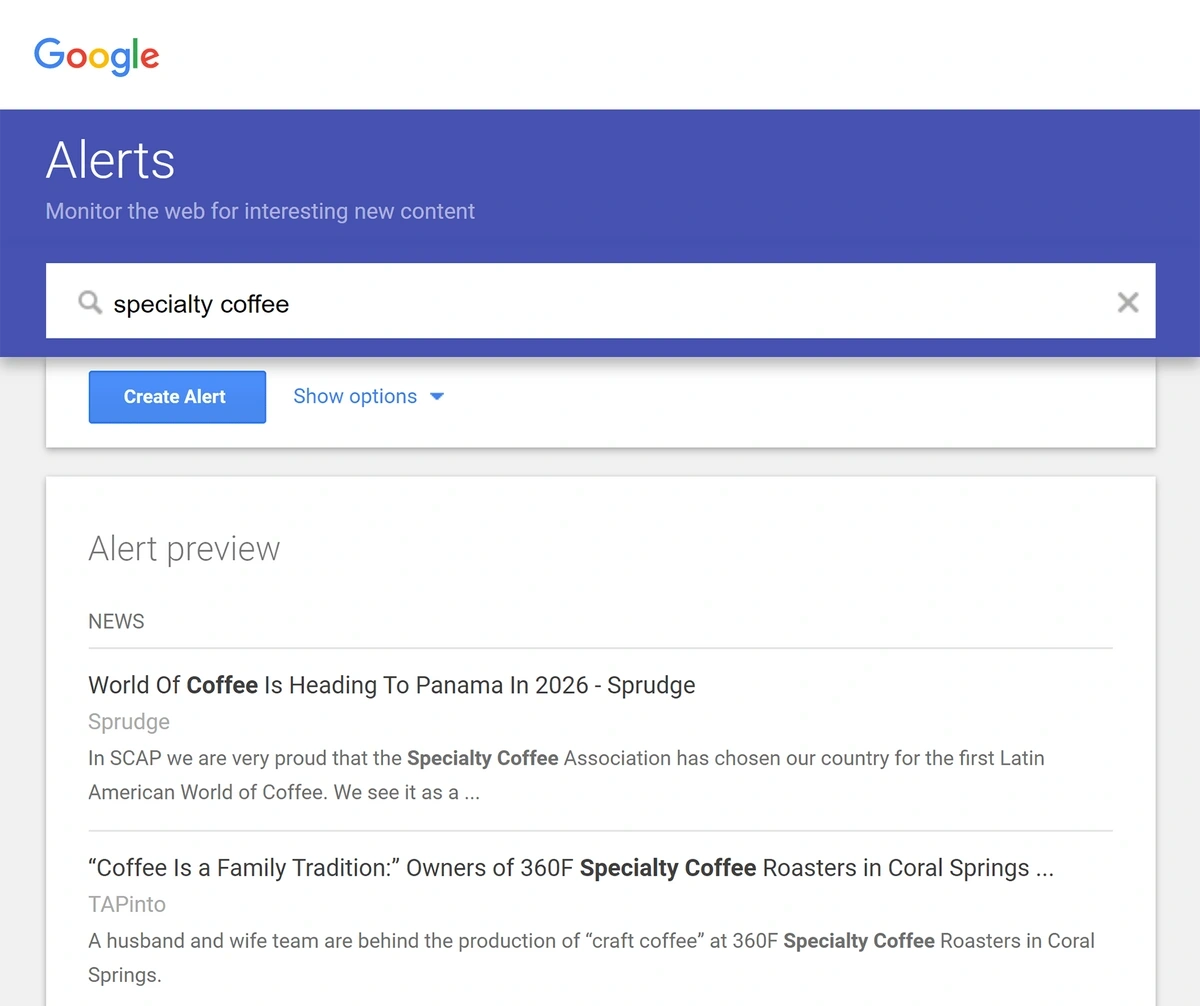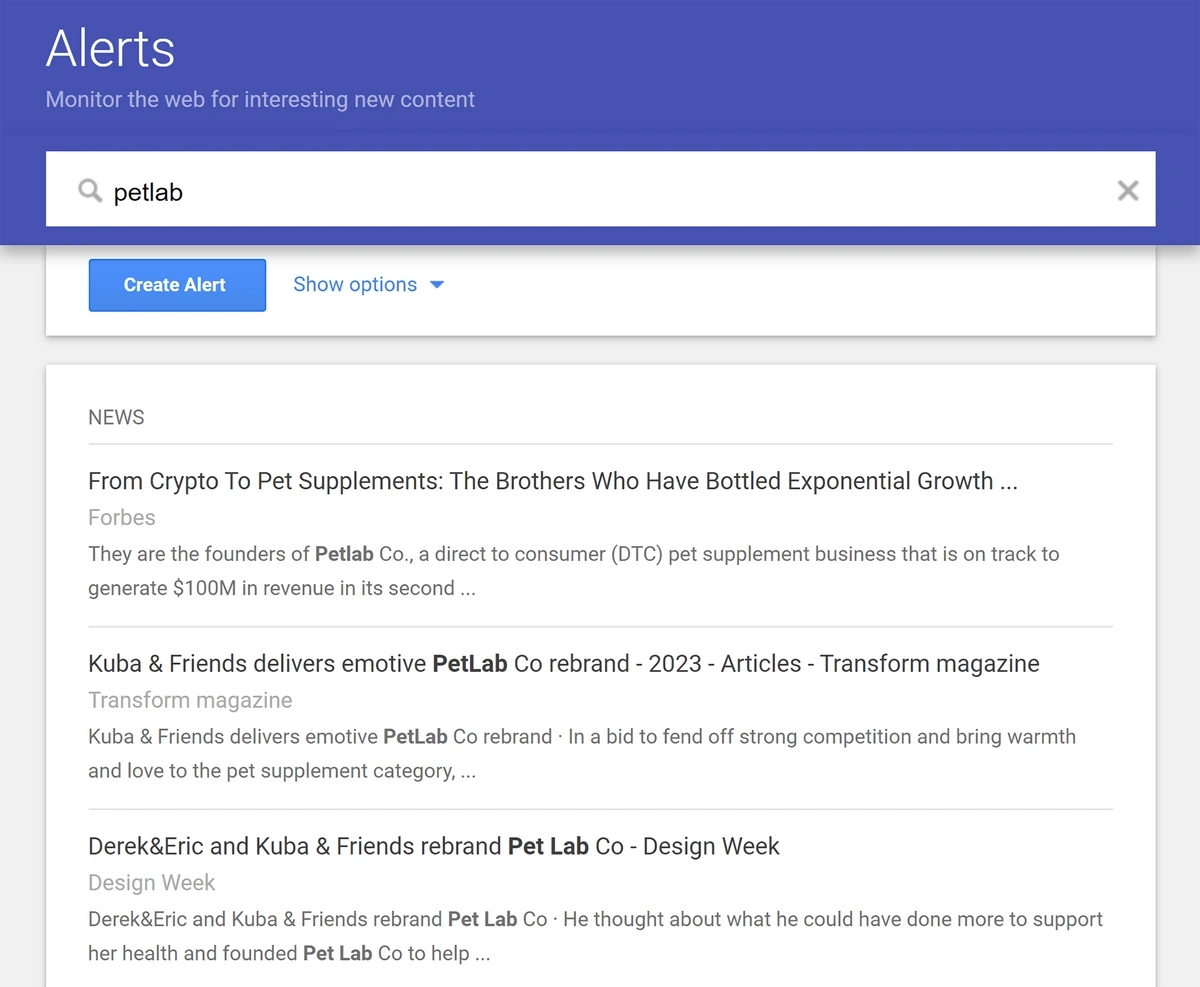
Trend Research: How to Find Relevant Trends
Most people discover trends by browsing social media, reading industry forums, or talking to industry experts. Yet this process is time-consuming, and you might still overlook the most important emerging trends.
Even after discovering a few trend ideas, you'll have to weed out the fads and buzzwords from legitimate trends worth investing in.
In this post, we'll show you how to research trends using a simple three-step process that makes it easy to quickly discover new trends, analyze their stability and growth potential, and monitor important activity.
Step 1: Identify Emerging Trends
You can find emerging trends in industry forums, podcasts, newsletters, and blog posts, but identifying just one or two trends can take hours.
A more efficient method is using a trend discovery tool that provides a database of emerging trends that you can filter by industry:
These tools make the discovery process faster, but trend suggestion quality varies depending on how each tool identifies and classifies trends.
So here are a few questions you can use to evaluate the trend quality of any trend discovery tool:
- How does it discover trends? Ideally, you want it to discover trends with AI or ML rather than a human analyst. Humans can only scan so much content, whereas AI and ML can scan millions of data points. So tools leveraging AI and ML are more likely to identify under-the-radar trends consistently.
- How does it define a trend? Does the tool qualify any popular topic as a trend? Or does it look at each topic's growth trajectory from the past several months and only qualify topics with steady compounding growth? Trend discovery tools that classify any popular topic as a trend may contain fads. And, you'll likely only see current trends rather than emerging trends.
- Are the trends relevant to your industry? Does it include pop culture trends, or does an analyst check each trend for business relevancy?
We struggled to find a trend discovery tool that consistently identified emerging trends relevant to business use cases. So we built our own trend discovery tool to meet our needs. Here's how Exploding Topics identifies and qualifies trends:
To discover trends with Exploding Topics, first select one of the dozens of B2B or B2C categories, ranging from artificial intelligence and sustainability to fitness and fashion:
Then, you’ll see hundreds of trending topics. Each topic is a brand name, product keyword, or industry topic.
The graph you see represents the topic’s Google Search volume trend, making it easy to gauge a topic’s growth trajectory at a glance:
To find the most promising trends, set the Status filter to "Exploding." You can also adjust the time period (e.g., three months, six months, one year, two years, five years, etc.), and the database automatically sorts topics with the strongest growth rate over that time period.
There are also a few other filter options, including:
- Growth: Fastest growth rate
- Trend Line: Most consistent compounding growth
- Discovered: The most recently discovered topics
- Search Volume: Topics with the highest search volume
You can click on any topic to see a forecast of its growth, the social media channel it’s trending on, and a number of related trending topics.
To save the topic, click "Track Topic" and add it to a Project.
Projects are files you create, and they make it easy to save and track trend ideas.
You can view all of your Projects in the Trend Tracking dashboard, and Exploding Topics will continue to update each topic's growth trajectory with real-time data.
This way, you never have to worry about managing spreadsheets.
Another trend discovery tool in Exploding Topics is the Meta Trends feature, which lists trending niches within broader markets.
Click on any of these meta trends to see a collection of the trending brands, products, and keywords within that niche.
Exploding Topics also has some other helpful trend discovery features.
The Trending Products dashboard is designed specifically for ecommerce brands and provides a database of trending product ideas.
You can sort the database by category (e.g., beauty, tech, fitness, health, etc.) and various other metrics, including:
- BSR
- Monthly sales
- Price
- Revenue
- Review stars
You'll also see a graph of each product keyword's Google search volume trend.
Another feature is the Trending Startups database, which provides a list of growing brands.
This database is great for investors and entrepreneurs who want to find growing startups.
You can filter the database by category, growth rate, and other specific metrics, like total funding, employee headcount, and location.
If you want to see for yourself how Exploding Topics expedites the trend discovery process, you can sign up for Exploding Topics Pro for $1.
If you'd rather manually research trends, here are a few tips.
First, you can use a tool like SparkToro to quickly generate a list of your industry's most popular podcasts, websites, forums, and social accounts.
Then, you can use an RSS feed like Feedly to create a curated news feed of content from the top blogs, newsletters, X accounts, and subreddits.
The downside is that Feedly only gives you a list of content. You might spot some trends from the titles of each piece of content, but it won't provide a specific list of trends.
Instead, you'll probably have to read the content to find new trends, and there's also the chance you may overlook emerging trends.
Another option is to use a tool like BuzzSumo. It offers a trend discovery feature that surfaces the most popular content in your industry.
This tool is great for content creators who want to view current industry trends and news, but it isn't designed for entrepreneurs or investors researching emerging market trends.
Step 2: Analyze Trend Growth
Once you have a list of trends, the next step is to weed out the fads from steady trends with long-term growth potential.
One easy way to quickly gauge a trend's growth is by looking at its historical Google Search volume data.
Steady compounding growth for that trend keyword is a good sign that demand will continue growing.
You’ll see a Google Search volume graph for each trend you find in Exploding Topics.
If you heard about a trend elsewhere and want to check its growth, you can type it into the Trends Search feature to instantly generate a report of its Google Search volume:
You can also use Google Trends.
Market forecast data can also help you gauge a market’s demand and stability.
Websites like Grand View Research, IBIS World, and MarketResearch.com offer some free market reports with this data.
The easiest way to find them is to Google the industry and “market report.”
Most provide a graph with market size data from the past several years and a forecast.
These reports also usually provide analysis to help you understand factors driving market growth.
For example, this report on the pet supplement market shows that demand is rising because there are more pet owners than ever before and pet owners are spending more money on their pets.
You can also gauge trend growth by looking at the growth patterns of the industry's leading brands.
To find leading brands, search the trend term and "brands" or "companies."
Then, you'll probably see a list of the top brands in the industry either directly from Google or in the organic search results:
If you're researching a trending ecommerce product, you can find leading brands by searching the trend keyword on Amazon:
Then, scroll down to see the list of top brands in the sidebar:
Once you have a list of brand names, type them into Google Trends to see an overview of their growth trend:
If most of these brands are growing, the trend is probably also growing.
If you're using Exploding Topics, you can also search each brand name in the Trends Search feature. Then, click "Track Topic" and save it to a Project.
For example, you can create a Project for all Pet Supplement brands.
Each trend saved to a Project is updated with real time data, so you can monitor growth just by glancing at the Trend Tracking dashboard:
This makes it easy to quickly gauge trend growth across the top brands in the industry.
Step 3: Monitor Trend Activity
All the trends you saved in Projects are automatically updated with real-time data, so you can just glance at the Trend Tracking dashboard to monitor trend growth.
If you're manually tracking trends, you can keep a spreadsheet with all the trends you want to track. Each month, you can type all of the trends into Google Trends and then download a CSV.
You can also use Google Alerts to monitor trends. This will help you stay up-to-date with the latest news on any of these trends, and it can help you identify industry influencers.
First, create an alert for the general trend term:
You can also create alerts for each of the top brands in the industry.
You can also use a competitive intelligence tool like Kompyte, AlphaSense, or Klue to monitor trends.
These tools make it easy to track any brand, and you can set alerts to be notified about:
- Marketing messaging changes
- New hires
- Product launches
- Marketing strategy
You can also track hashtags for key trends you're monitoring.
For example, if you're monitoring the trend "ketamine therapy," you can track "#ketaminetherapy" in a tool like BrandMentions. This tool offers a free report that shows the most popular content across the web with that hashtag and other related hashtags.
If you're using the paid version of BrandMentions, you can schedule weekly reports for your tracked hashtags.
This is an easy way to stay up-to-date with the latest trend news and participate in important trend conversations.
Start Researching Trends In Your Industry Today
There are many methods to research trends, but most strategies are time-consuming, and you might overlook important emerging opportunities.
And even if you find a new trending topic, it's difficult to distinguish fads from long-term trends.
That's why we built Exploding Topics.
We wanted a method to quickly identify emerging trends and passively track them.
If this is a solution you're looking for, consider trying Exploding Topics Pro for $1 today.
Stop Guessing, Start Growing 🚀
Use real-time topic data to create content that resonates and brings results.
Exploding Topics is owned by Semrush. Our mission is to provide accurate data and expert insights on emerging trends. Unless otherwise noted, this page’s content was written by either an employee or a paid contractor of Semrush Inc.
Share
Newsletter Signup
By clicking “Subscribe” you agree to Semrush Privacy Policy and consent to Semrush using your contact data for newsletter purposes
Written By


Josh is the Co-Founder and CTO of Exploding Topics. Josh has led Exploding Topics product development from the first line of co... Read more

